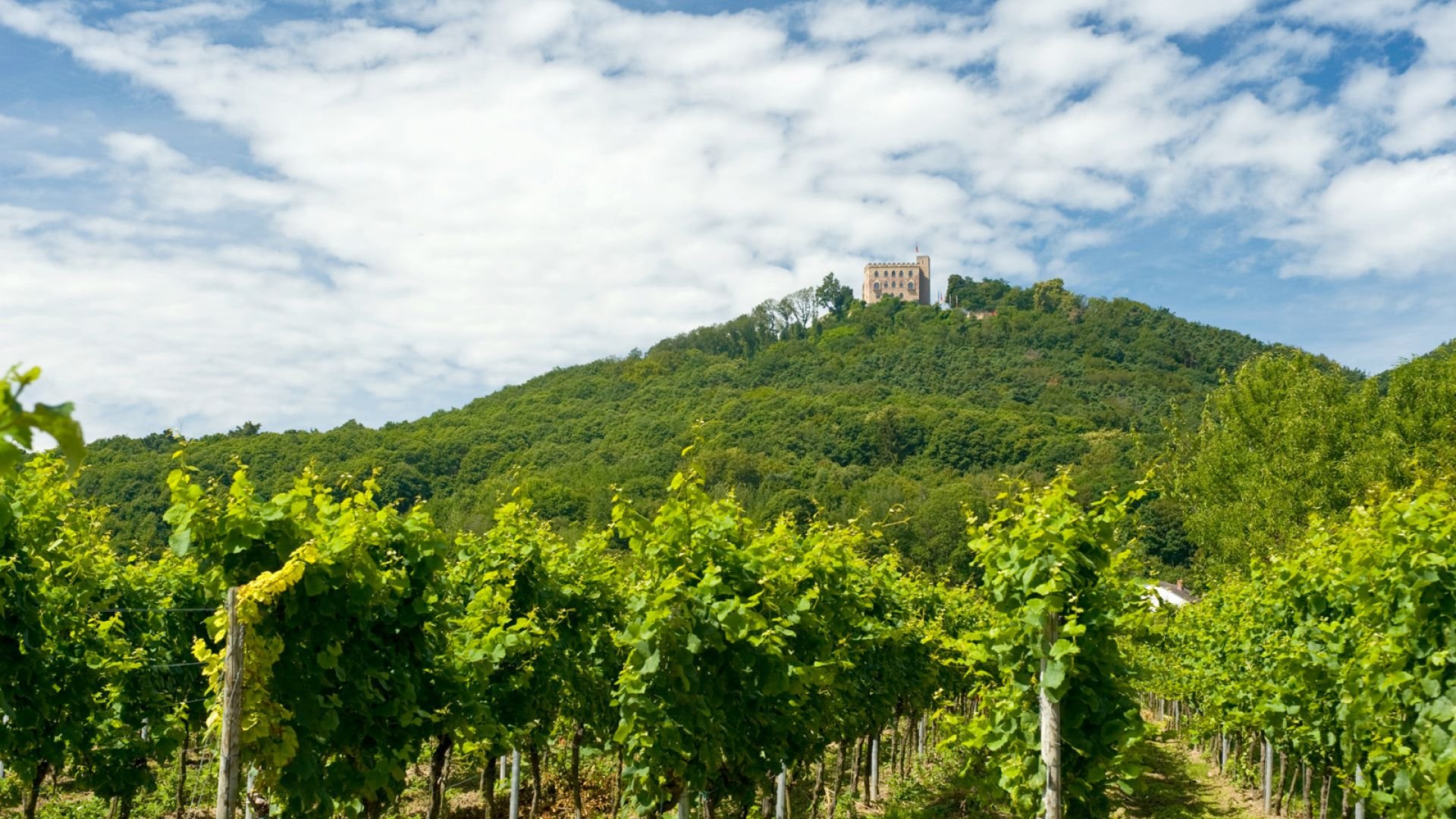Wine Hikes in Germany
Compiled by Chloe Gellar / Images courtesy of Wines of Germany (germanwines.de)
Germany's Oldest Wine Route: The Palatinate
Riesling, pinot blanc, Grüner Silvaner, and chardonnay grapes originate in the Palatinate. The region between the Palatinate Forest and the Rhine Plain is located in Rhineland-Palatinate, bordering Alsace in the south. In terms of landscape, this region is strongly influenced by wine, with endless vines reaching in soft sweeps down to the Rhine and Moselle. The winters are mild, and the summers pleasant. Lemons, figs, and kiwis grow in the country gardens. Germany's oldest wine route runs through the middle of the Palatinate. At 52 miles in length, the trail starts at the German Wine Gate in Schweigen Rechtenbach on the French border and ends in Bockenheim on the edge of the Rhine-Hesse. There are 130 idyllic wine villages interspersed with stately castles and palaces, with wine festivals in summer and almond blossoms in spring. The picturesque municipalities of Bobenheim, Birkweiler, and Neustadt are noteworthy.
Quite small, but very refined: Franconia
In the Middle Ages, Franconia was regarded as the largest wine region in the Holy Roman Empire; today, it is one of the more moderately-sized wine-growing regions. The region's trademark is the bocksbeutel, a type of wine bottle shaped like a flattened ellipsoid. The area surrounding Würzburg stretches from Aschaffenburg along the Mainschleife to Bamberg and includes the steep slopes of the Steigerwald. Müller-Thurgau, Grüner Silvaner, riesling, and the typical Franconian Bacchus are grown here. Every year, 200 wine-related festivals occur in Franconia, nestled between the Spessart, Rhön, Steigerwald, and Tauber valleys.
The route from Retzbach to Karlstadt or from Rothenfels to Kreuzwertheim is a good option. Along the Volkacher Mainschleife, you can expect Silvaner wine and a breathtaking view of Vogelsburg. Red wine lovers can go on the red wine hike to Dernau. Finally, don't miss the Marienburg fortress and the residential city of Würzburg, with its imposing cathedral.
The steepest vineyards in Europe: Moselle
It is one of the country's oldest wine regions, known for the steepest vineyards in Europe. Here, rieslings, Müller-Thurgau, and pinot noir flourish in primeval shale. The sheer grade is made for experienced hikers, rewarding them with unique views of an enchanting cultural landscape replete with castles, vineyards, waterfalls, ostrich farms, and legendary wine villages. Cochem and Bremm are popular towns, and the walled city of Beilstein, with its chapels and castle ruins, is undoubtedly worth a visit.
The Calmont ropeway offers hikers a unique view of the Bremmer Mosel loop, and it's well worth a walk to the steel lookout tower at Prinzenkopf. Those who tour Moselhöhenweg get an impressive look at miles of ornately arranged wine terraces. Trek along the wine trail on the Petrisberg to gaze upon Germany's oldest city, Trier. The culture trail in the Moselle valley is a less strenuous but equally exciting trek.
Forever Following the Rhine Terraces: Rheinhessen
Between Worms, Mainz and Bingen is Germany's largest and oldest wine-growing region, the Rhineland-Palatinate wine region of Rheinhessen. Of the 136 Rhine-Hessian areas, only a fraction don't produce wine. The mild climate and the diverse soil conditions produce interesting wines from grapes that include Müller-Thurgau, Silvaner, riesling, Dornfelder, and Burgundy Germany's richest rieslings hail from the Rote Hang between Nierstein and Nackenheim. The 46-mile Rhine Terraces Trail is divided into six stages and passes through many hamlets, all of which invite you to taste their wines.
Routes between Worms and Osthofen, Oppenheim to Nackenheim, and Bodenheim to Mainz are ideal routes. In Worms and Mainz, numerous sights and cozy pubs await. Also notable are the Bensheim circular hiking trail, the gourmet hike in Oppenheim, and the lookout at Nollig Castle.
Lovely Weather, Wonderful Wine: Baden
Baden, the "Burgundy Paradise," is one of Germany's most versatile wine-growing regions, stretching about 250 miles along the Upper Rhine Plain from Tauberfranken through Kraichgau and the Badische Bergstrasse to Lake Constance. Such vastness creates ideal conditions for growing wide varieties of grapes. The sun plays along, too, making the highest recorded temperatures in Germany on the southern slopes of the Kaiserstuhl. And since Burgundy grapes are particularly fond of the warm climate, Baden is especially well-known for this variety.
The undulating Baden-Ortenau Wine Trail passes through ancient cities such as Freiburg, Heidelberg, and Baden-Baden, along with Lake Constance. An eco-wine trail also leads through the Markgräfler Land. The view from the dainty half-timbered village of Sasbachwalden, located between the slopes of the Hornisrinde and vineyards with a view of France, the Rhine Valley, and Strasbourg, is stunning. The Ortenau Wine Trail is also well worth a mention.
The German Wine Institute has an interactive map on its website (germanwines.de/tourism/wine-hiking-trails/) showing more than 50 wine hikes in all 13 German wine-growing regions. Users can search for the locations of over 2,300 wine producers and special events.
The Rhineland-Palatinate
Franken wine region
Mosel wine region



